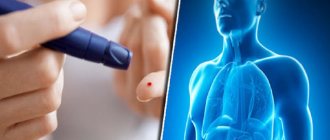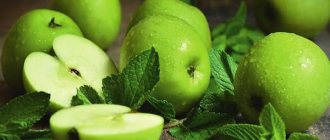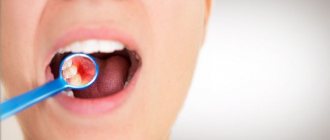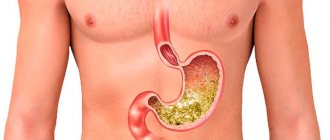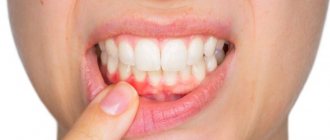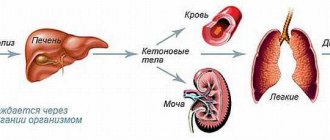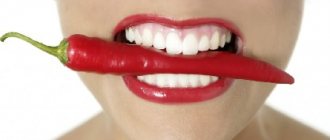Halitosis
(halitosis; from Latin halitus - breath and Greek -osis - disease) or halitosis is a term used to describe a noticeably unpleasant odor when exhaling.
It is known to be the third most common reason, after tooth decay and gum disease, that prompts people to visit the dentist.
For a person with halitosis, the symptoms are invisible because the olfactory receptors become accustomed to the stench. In most cases (90%) the cause of bad breath is in the mouth.
The intensity of this phenomenon can change throughout the day due to the consumption of odorous foods such as cheese, fish, seasonings, garlic, alcohol, as well as smoking and, in general, overeating.
Since self-cleaning does not occur in the mouth during sleep, halitosis is usually more intense in the morning (“kittens wrote in their mouth”).
Bad breath can be ephemeral (going away after rinsing with a freshener or brushing your teeth) and persistent.
Sustained (chronic, persistent) halitosis is present in 25% of the population.
Bad breath: physiology or disease?
Bad breath
in medical language it is called
halitosis
. There are physiological and pathological halitosis. Bad breath often appears in the morning. During the night, bacteria and their metabolic products accumulate in the mouth, which causes a bad odor. This type of halitosis is physiological and can be eliminated by simply brushing your teeth. Physiological halitosis also includes odor caused by eating a number of foods, such as garlic, onions, cabbage. This smell will disappear on its own as soon as the substances that caused it are eliminated from the body. But it also happens that an unpleasant odor is not eliminated using hygiene procedures; in this case, most likely, it is of a pathological nature.
Diagnosis of halitosis.
Self-diagnosis.
Smelling your own breath is difficult due to the adaptation of the olfactory receptors, although many halitosis sufferers can smell it in others.
Sometimes people experience an unpleasant taste in their mouth, but this is not always accompanied by halitosis. Usually people reliably learn about the presence of halitosis from their loved ones or from their doctor.
Special diagnostics.
It is required if the possible causes of halitosis, especially in the mouth, have been eliminated.
2.1. Halitometer
This is a device that determines the amount of hydrogen sulfide in exhaled air. Other odorous agents, such as mercaptan, are not detected by this device.
2.2. Digital gas chromatograph
measures the molecular level of major halitosogenic substances.
Bad breath: causes
The most common cause of unpleasant odor is the active activity of pathological bacteria in the oral cavity. Diseases such as caries, periodontitis, pulpitis, periodontitis, gingivitis, stomatitis, as well as the formation of tartar can lead to persistent bad breath.
The second place among the causes of unpleasant odor is dry mouth (the medical term is xerostomia
). Mica, which moisturizes our mouth, has bactericidal properties. It kills bacteria, neutralizes their waste products, rinses and cleanses the oral cavity. If there is not enough saliva produced, bacteria are activated, resulting in an odor. Dry mouth can be a consequence of illness or taking a number of medications. It can also be caused by age: over time, the salivary glands begin to work less intensively, the composition of saliva changes, and its antibacterial properties are lost.
The smell can also be caused by ENT diseases: sore throat, chronic tonsillitis, sinusitis, runny nose.
Another cause of unpleasant odor is diseases of the internal organs. It can be:
- renal failure;
- liver failure;
- gastric diseases (gastritis, stomach ulcer);
- lung diseases.
Smoking is also a cause of persistent bad breath. The smell is caused by substances contained in tobacco smoke and deposited in the oral cavity. The only way to eliminate the unpleasant odor in this case is to quit smoking.
In what cases should you be concerned about such a symptom?
In any case, it is logical to consult a physician, dentist or gastroenterologist when halitosis appears to rule out the presence of serious health problems. Having found out the true causes of the unpleasant “aroma”, together with the doctor it is necessary to determine further tactics of behavior.
If halitosis is associated only with dietary restrictions or fasting, then only successful “masking” of it will be a sufficient measure. Otherwise, you should immediately begin treatment of organs that are malfunctioning in the body.
Another important note: it is advisable to carry out any dietary restriction only under the “supervision” of a qualified specialist (nutritionist or doctor), otherwise it is possible that there will be many more health problems than the expected benefits.
also necessary to “enter” and “exit” the diet gradually : the body may experience severe stress, which will not have the best effect on its condition.
What is bad breath like?
Peculiarities of odor can indirectly indicate the source of problems.
Hydrogen sulfide smell
(the smell of rotten eggs) indicates rotting protein substances. This smell is typical for digestive problems. A persistent hydrogen sulfide odor may indicate gastritis with low acidity or a stomach ulcer.
Sourish smell
and a corresponding taste in the mouth is noted with gastritis with high acidity. This smell may appear at an early stage of the disease, when other symptoms are not yet present.
Bitter smell
and the taste in the mouth is typical of liver and gallbladder diseases. An additional symptom is the appearance of a yellow coating on the tongue.
Smell of acetone
and the accompanying sweet taste in the mouth is a characteristic symptom of diabetes.
Urine smell
from the mouth indicates a disease of the genitourinary system (primarily the kidneys or bladder).
Stool smell
from the mouth can occur due to intestinal diseases (dysbacteriosis, intestinal dyskinesia, intestinal obstruction).
Putrefactive
bad breath is typical for dental diseases (inflammatory processes of teeth and gums).
What does a healthy person's skin smell like?
The sweat of healthy people should not smell like anything. Each person is universal, has his own body aroma depending on how he lives and takes care of his health. Theoretically, people can be divided into 3 main groups:
- Sweat doesn't smell. This suggests that there is no large accumulation of toxins and bacteria in the body of such a person. Most likely, he leads a healthy lifestyle, watches his diet, exercises moderately and visits doctors. Or he was simply lucky to be born with a good immune system that does not allow viruses and bacteria. Strong immunity reduces the risk of catching a sore and acquiring the smell of viburnum from the body.
- Nice smell. 50% of people think their scent has a pleasant note. Men especially hold this opinion. In fact, this also happens. Some smell like paprika, rose, dessert. But a tasty body odor does not always indicate the proper functioning of organs. However, if you feel great and take care of your hygiene, then there is no point in steaming.
- The smell of hydrogen sulfide from a person. Nutritionists say that a person smells what he eats. And this is so, since fatty, spicy, high-calorie foods can negatively affect all organ systems. The more waste products remain in our body, the more toxins accumulate in it. And toxins come out through sweat and give off an unpleasant body odor.
The main thing to remember is that sweat is not to blame. On the contrary, with the help of sweating, all the “rubbish” comes out of a person, led by bacteria and harmful toxins. It also supports thermoregulation at different ambient temperatures. And the smell of sweat depends on the type of bacteria, and not on their number in the body.
Have you noticed that there are people who sweat a lot, but don’t smell at all? And there are people who sweat a little during physical activity, but have a strong odor. This once again proves that it is not a matter of quantity, but of quality. In our case, the quality of the state of the body.
Bad breath: what to do?
The fight against bad breath begins with careful adherence to good oral hygiene. If the source of the odor is bacterial activity, proper brushing of your teeth will help. Teeth should be brushed not only from the outside, but also from the inside, and also treat the chewing surface of the teeth. The brush angle should be 45°. Using dental floss, hard-to-reach areas between teeth are treated. If your teeth are in poor condition, simply brushing your teeth will not solve the problem. You will need to visit a dentist and remove tartar, and if your teeth have caries, cure them. It is recommended to visit the dentist at least once or twice a year.
It is also necessary to combat dryness of the oral mucosa. If you feel dry mouth, take a few sips of water and rinse your mouth. However, it should be remembered that frequent dry mouth can be a symptom of serious diseases. However, like the unpleasant smell itself. Therefore, if you have persistent bad breath, you should definitely see a doctor and undergo an examination.
Treatment and prevention.
1.
It is known that very few people observe sufficient personal hygiene measures necessary for fresh breath.
This is, firstly, adequate teeth cleaning using electric, sonic and ultrasonic toothbrushes and irrigators with quality control using special plaque indicators.
Secondly, it is advisable to clean the tongue with a scraper and brush. Medicinal rinses are also appropriate.
2.
Diet. When eating raw, hard vegetables and fruits, the oral cavity self-cleanses.
3.
High-quality regular, if necessary repeated, professional teeth cleaning with removal of plaque and stones using ultrasound and sandblasting (air-flo).
Sometimes deep scaling, root planing and gum margin management are required. In advanced cases, reconstructive gum surgery is used.
4.
Dental treatment and adequate dental prosthetics.
Drug therapy.
1.
Antimicrobial drugs.
2.
Probiotics. For example Streptococcus salivarius K12.
6. Traditional medicine.
Camomile tea.
Pour a teaspoon of chamomile flowers into a glass of boiling water, leave for 2 hours, strain. Rinse your mouth with freshly prepared chamomile infusion 3 times a day.
Bibliography:
- Maksimova E. V., Stetsyuk N. S., Shelikhova E. O. “Halitosis as a medical and social problem.” Crimean therapeutic journal, No. 1, 2020, pp. 32-37.
- Gorobets S. M., Romanenko I. G., Bobkova S. A., Dzherelei A. A., Kryuchkov D. Yu., Gorobets O. V. Risk factors for the development of halitosis (review). Crimean therapeutic journal, No. 3 (34), 2022, pp. 13-18.
- Karpishchenko S., Lavrenova G., Malay O., Milchakova A. Possibilities for correcting halitosis in chronic tonsillitis. Doctor, No. 2, 2022, pp. 50-52.
- Tyomkin E. S., Churikova A. S. Halitosis - modern diagnostic methods and their prospects. Volgograd Medical Scientific Journal, No. 3, 2022, pp. 15-18.
- Suyunova M. Kh. Everything about halitosis: diagnosis, treatment and prevention (review article). Bulletin of the Council of Young Scientists and Specialists of the Chelyabinsk Region, T. 1, No. 4 (15), 2016, pp. 68-77.
- GAUZ TO "Regional Center for Medical Prevention, Physical Therapy and Sports Medicine", Prevention of dental and oral diseases, methodological manual, 2022, 36 p.
- Namkhanov V.V., Pisarevsky Yu.L. The role of oral hygiene in inflammatory periodontal diseases. Bulletin of Buryat State University. Medicine and Pharmacy, No. 1, 2022, pp. 62-65.
- Prevention of dental diseases: textbook / S.I. Borodovitsina, N.A. Savelyeva, E.S. Tabolina; Federal State Budgetary Educational Institution of Higher Education Ryazan State Medical University of the Russian Ministry of Health. – Ryazan: OTSIOP, 2022. – 264 p.
- Shavlokhova D. T., Dzgoeva M. G., Dzhanaev B. M. Study of antibacterial activity and clinical effectiveness of rinses: chlorhexidine, listerine and carsodyl. Medical and pharmaceutical journal "Pulse", T. 14, No. 4, 2012, pp. 319-320.
- Khromova M.I., Suzanskaya M.A. The influence of balms-rinses on the microbiota of the oral cavity. FORCIPE, T. 3, No. 5, 2022, pp. 486-487.
- Internal research dated 07/09/2010. Internal reports for studies by Minoli G., October 3, 2008 Ilg D et al, Febriary 20, 2009.
- Kuzmina E.M., Lapatina A.V., Smirnova T.A. The use of antibacterial rinses for the prevention of periodontal diseases. Tutorial. Moscow. 2012 (from brands)
- "Tooth Discoloration: Article by Jonathan A Ship, DMD. Addy M, et al. J Dent. 1995; 23: 95-99.
- Overholser CD, et al. J Clin Periodont. 1990; 17:575–579.
- Minach et al. The effect of 6 months of use of an antiseptic rinse on the microflora of supragingival dental plaque. Journal of Clinical Periodontology. 1989. July; 16(6):347-52
- https://www.ncbi.nlnn.nih.gov/
- Cortelli et al. Gum health benefits of using an essential oil mouthwash and a CPC-based mouthwash: a 6-month randomized clinical trial. American Dental Journal. 2014; 27(3): 119-126
- Modern methods of diagnosis, elimination and prevention of halitosis: textbook / R.V. Ushakov, N.B. Eliseeva, N.P. Polevaya, N.M. Belova, V.V. Korkin. GBOU DPO "Russian Medical Academy of Postgraduate Education". M.: GBOU DPO RMAPO, 2016. 81 p. ISBN 978-5-7249-2549-5
